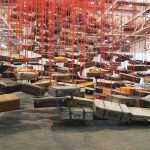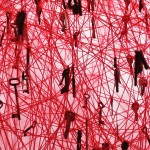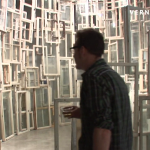“Who am I Tomorrow?” is a new site-specific installation by Japanese artist Chiharu Shiota, created for the Kunstraum in Dornbirn, Austria. Chiharu Shiota isolates the human blood circulation from the systemic whole, enlarges it and inserts it into the hall structure. The exhibition runs until 12 November 2023.
Chiharu Shiota: Who am I Tomorrow? / Kunstraum Dornbirn. Dornbirn (Austria), July 6, 2023.
> Right-click (Mac: ctrl-click) this link to download Quicktime video file.
Extended version (7:35 min.):
Press text (excerpt):
In the former assembly hall, a red, entwined labyrinthine mesh hangs overhead. It takes up the entire exhibition space and as soon as we enter, we are right in the middle of it. As we look more and more closely, we recognise intertwined tubes. Suspended from the 11-metre-high ceiling on more than 5,000 red threads, the material seems not static at all, but rather in motion: through 2,500 metre-long paths in countless coils flows a red liquid. At some points, tubes break away from the compound and lead downwards, via a medical pump, into an Erlenmeyer flask.
The installation with the evocative title “Who am I Tomorrow?” by Chiharu Shiota unfolds the fascinating impression of a living, oversized and independent organism. It seems to hover above the visitors, precisely fitted into the protective historical architecture, connected to it by an uncountable number of red connecting lines.
Shiota here turns the inside out. We all live, work, sleep, love and suffer physically driven by a constantly functioning cardiovascular system. With a heartbeat of about 70 beats per minute, approximately 10,000 litres of blood are pumped into around 100,000 kilometres of blood vessels every day. Shiota isolates this blood circulation from the systemic whole, enlarges it and inserts it site-specifically into the hall structure. The function of the heart is taken over by the pumps, which move apparent blood through the veins. For a short time, the blood is even completely removed from the circulation in the Erlenmeyer flask and kept in the vessel to be fed back into the flow through the next open vein with the help of the pump. This process is similar in medicine to the out-of-body circulation accomplished with the help of a heart-lung machine and used in open-heart surgery.
In the exhibition, the absence of the corresponding body reflects the exact opposite, namely the conscious presence of the body. For without the body, the circuit simply does not exist. It is interwoven into a sophisticated system in which a loss of function of one part affects all the others. This interior as the core of physical existence, as depicted here, finds its repeated representation in Shiota’s entire œuvre. The direct connection of the inside with the outside corresponds to a layering in the artistic work: the inner organism surrounded by the skin, protected by clothing, sheltered in the bed, the room, the flat/house, located in the city, the country, the continent, the world. Just that world in a universe where only on planet earth we can coexist with all other living beings and are responsible for keeping this community in balance and securing our living space. In this universal context, blood stands not only allegorically but factually for the individual’s information about origin, nation, family, health and illness. In the best case, blood is invisibly hidden, imperceptible, absent to the senses and thus fascinating and frightening, or its visibility is associated with injury, loss and other extreme situations and blows of fate.
The analogy of the artistic intervention to the circulation of the blood is not limited to humans. It is equally valid for other living beings and so formulates the connection of human being with its entire environment as a central theme in Shiota’s work. The representability of the inner, of psychological states – experiences, traumas, fears, blows of fate or moments of happiness, a sense of security or social mortification – finds its correspondence in the giving of artistic form. In this, the personal, the intimate, intertwines with the public. For Shiota, her art is a home, a medium of communication with the world. And she constantly creates this sense from within herself, taking her own experiences as her impetus and subject. For almost three decades, she has been developing a consistent, highly aesthetic and internationally successful formal language. In it, she negotiates her own history, her identity and the cultures in which she grew up and lived/lives. She works with the connotative attributions she experiences as a Japanese woman, as a daughter, as a mother, as a wife, as someone who has recovered from cancer, as someone traumatised by a miscarriage, as a sister and an artist taking part in an international business. Shiota does this in expansive installations, such as her now iconic thread tangles, but also in drawings, videos, performances and objects. In her work, her own experiences become a point of reference for the recipients; the individual is merged into the collective experience.
The very title of the Dornbirn exhibition shows: it is about me, that is, about an individual, the smallest unit of a community: “Who am I Tomorrow?” No less than the question of identity is posed here in all its complexity, with all its possible dissonances – in biographical and biological experiences, in behaviour and habit, in social and cultural context, in the consciously addressable and unconsciously effective, in the zeitgeist and across generations. Reading the question, we automatically think about what could happen by tomorrow, proceeding from the current overall state, so that we are someone else, can never again be or want to be that someone of today. How much influence do we have on that? How much power does our environment have? And how much responsibility do we have for this environment in a constantly reciprocal relationship? “Tomorrow” is a concrete temporal specification, relatively little time passes until then. So how big can our own transformation be? What does tomorrow’s version of me look like? And what will it change?
In “Who am I Tomorrow?” Shiota asks these questions and many more in a catchy semantic setting. In its pure size and harmonious beauty, the installation is such an intense experience that we become aware of our own connectedness with this large world in a special way. The artistic language can be grasped intuitively, and it is impressive how globally understandable and valid it is. The amount of responsibility that falls to our lot in today’s globalised world is constantly growing and its recognition is hindered by invisibility, which is due, among other reasons, to great distances and media mediation. But human beings are capable of compassion, and so of changing perspectives and raising their awareness. To this end, Shiota’s installations create imaginary spaces of real stories. They provide us with identity-forming narratives whose feedback to the reality of life is palpable and full of hope.
Chiharu Shiota was born in 1972 in the Osaka Prefecture, Japan, and has lived in Berlin since 1998. She studied at Seika University in Kyoto from 1992 to1996 and attended the University of the Fine Arts in Hamburg from 1996-1997. She then studied at the University of Art in Brunswick until 1999 and subsequently at the University of Arts in Berlin until 2003. Her work has been presented in numerous solo and group exhibitions worldwide and represented Japan at the Venice Biennale in 2015.









